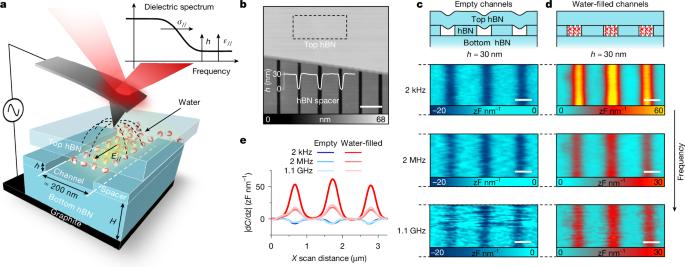In-plane dielectric constant and conductivity of confined water
IF 48.5
1区 综合性期刊
Q1 MULTIDISCIPLINARY SCIENCES
引用次数: 0
Abstract
Water is essential for almost every aspect of life on our planet and, unsurprisingly, its properties have been studied in great detail1. However, disproportionately little remains known about the electrical properties of interfacial and strongly confined water2,3, in which the structure deviates from that of bulk water, becoming distinctly layered4,5. The structural change is expected to affect the conductivity of water and particularly its polarizability, which in turn modifies intermolecular forces that play a crucial role in many physical and chemical processes6–9. Here we use scanning dielectric microscopy (SDM)10 to probe the in-plane electrical properties of water confined between atomically flat surfaces separated by distances down to 1 nm. For confinement exceeding several nanometres, water exhibits an in-plane dielectric constant close to that of bulk water and its proton conductivity is notably enhanced, gradually increasing with decreasing water thickness. This trend abruptly changes when the confined water becomes only a few molecules thick. Its in-plane dielectric constant reaches large, ferroelectric-like values of about 1,000, whereas the conductivity peaks at several S m−1, close to values characteristic of superionic liquids. We attribute the enhancement to strongly disordered hydrogen bonding induced by the few-layer confinement, which facilitates both easier in-plane polarization of molecular dipoles and faster proton exchange. This insight into the electrical properties of nanoconfined water is important for understanding many phenomena that occur at aqueous interfaces and in nanoscale pores. Scanning dielectric microscopy of nanocapillaries filled with water reveals that interfacial and strongly confined water exhibits a large in-plane dielectric constant and an in-plane conductivity approaching superionic values.

承压水的面内介电常数与电导率
水对我们这个星球上生命的几乎每一个方面都是必不可少的,毫不奇怪,人们对水的特性进行了非常详细的研究。然而,对界面水和强承压水的电学性质知之甚少2,3,其中的结构偏离了散装水的结构,变得明显分层4,5。这种结构变化预计会影响水的导电性,特别是其极化性,从而改变在许多物理和化学过程中起关键作用的分子间力6 - 9。在这里,我们使用扫描介电显微镜(SDM)10来探测被限制在原子平面之间的水的平面内电学性质,这些平面之间的距离低至1nm。对于超过几纳米的约束,水的平面介电常数接近于体积水的介电常数,其质子电导率显著增强,随着水厚度的减小而逐渐增加。当密闭水变得只有几个分子厚时,这种趋势就突然改变了。它的面内介电常数达到较大的类似铁电的值,约为1000,而电导率在几S m−1处达到峰值,接近超离子液体的特征值。我们将这种增强归因于少层约束引起的强烈无序氢键,这既促进了分子偶极子的平面内极化,又促进了质子交换。对纳米密闭水的电学性质的深入了解对于理解发生在水界面和纳米级孔隙中的许多现象非常重要。充满水的纳米毛细管的扫描介电显微镜显示,界面水和强约束水具有较大的面内介电常数和接近超离子值的面内电导率。
本文章由计算机程序翻译,如有差异,请以英文原文为准。
求助全文
约1分钟内获得全文
求助全文
来源期刊

Nature
综合性期刊-综合性期刊
CiteScore
90.00
自引率
1.20%
发文量
3652
审稿时长
3 months
期刊介绍:
Nature is a prestigious international journal that publishes peer-reviewed research in various scientific and technological fields. The selection of articles is based on criteria such as originality, importance, interdisciplinary relevance, timeliness, accessibility, elegance, and surprising conclusions. In addition to showcasing significant scientific advances, Nature delivers rapid, authoritative, insightful news, and interpretation of current and upcoming trends impacting science, scientists, and the broader public. The journal serves a dual purpose: firstly, to promptly share noteworthy scientific advances and foster discussions among scientists, and secondly, to ensure the swift dissemination of scientific results globally, emphasizing their significance for knowledge, culture, and daily life.
 求助内容:
求助内容: 应助结果提醒方式:
应助结果提醒方式:


